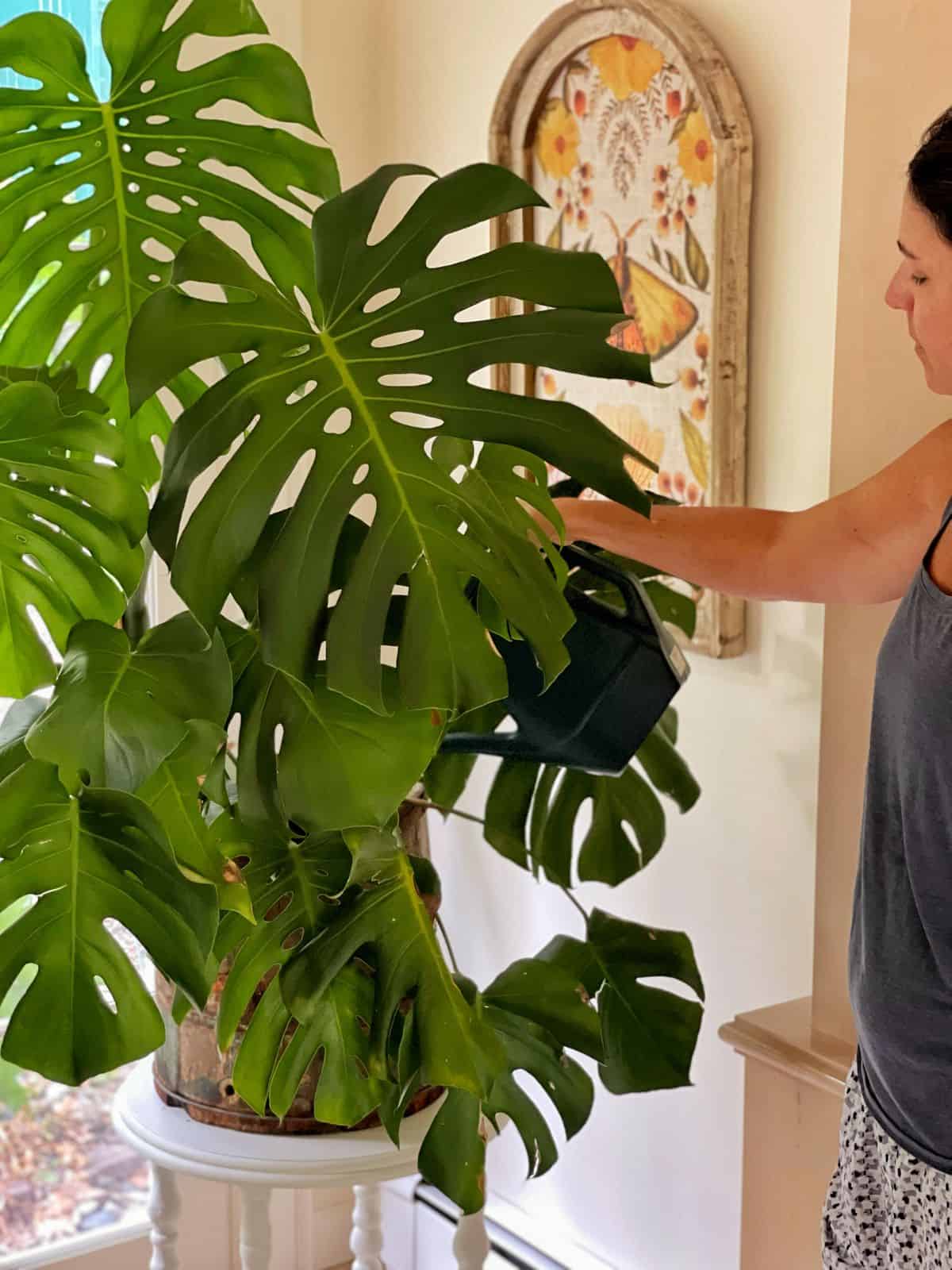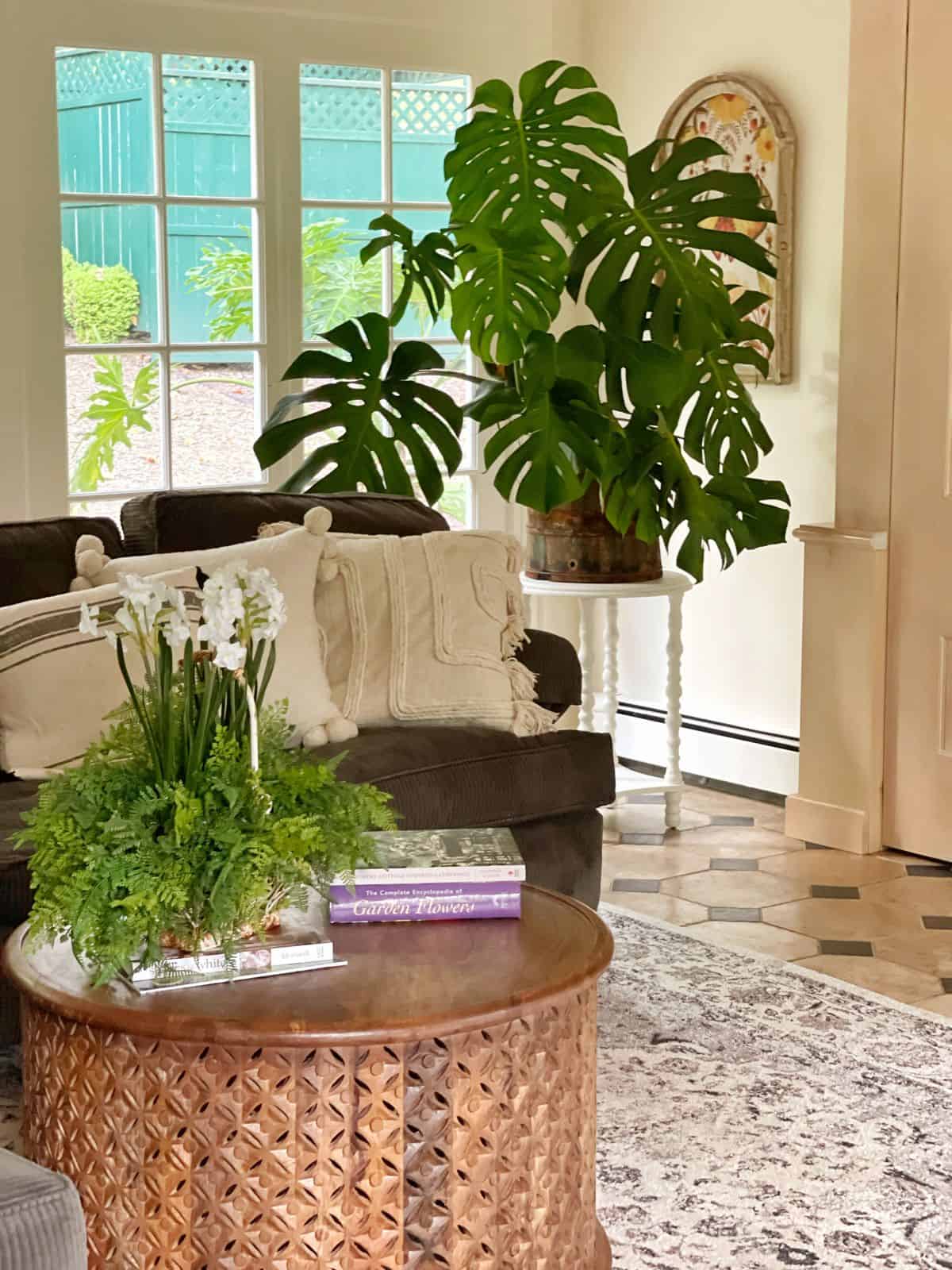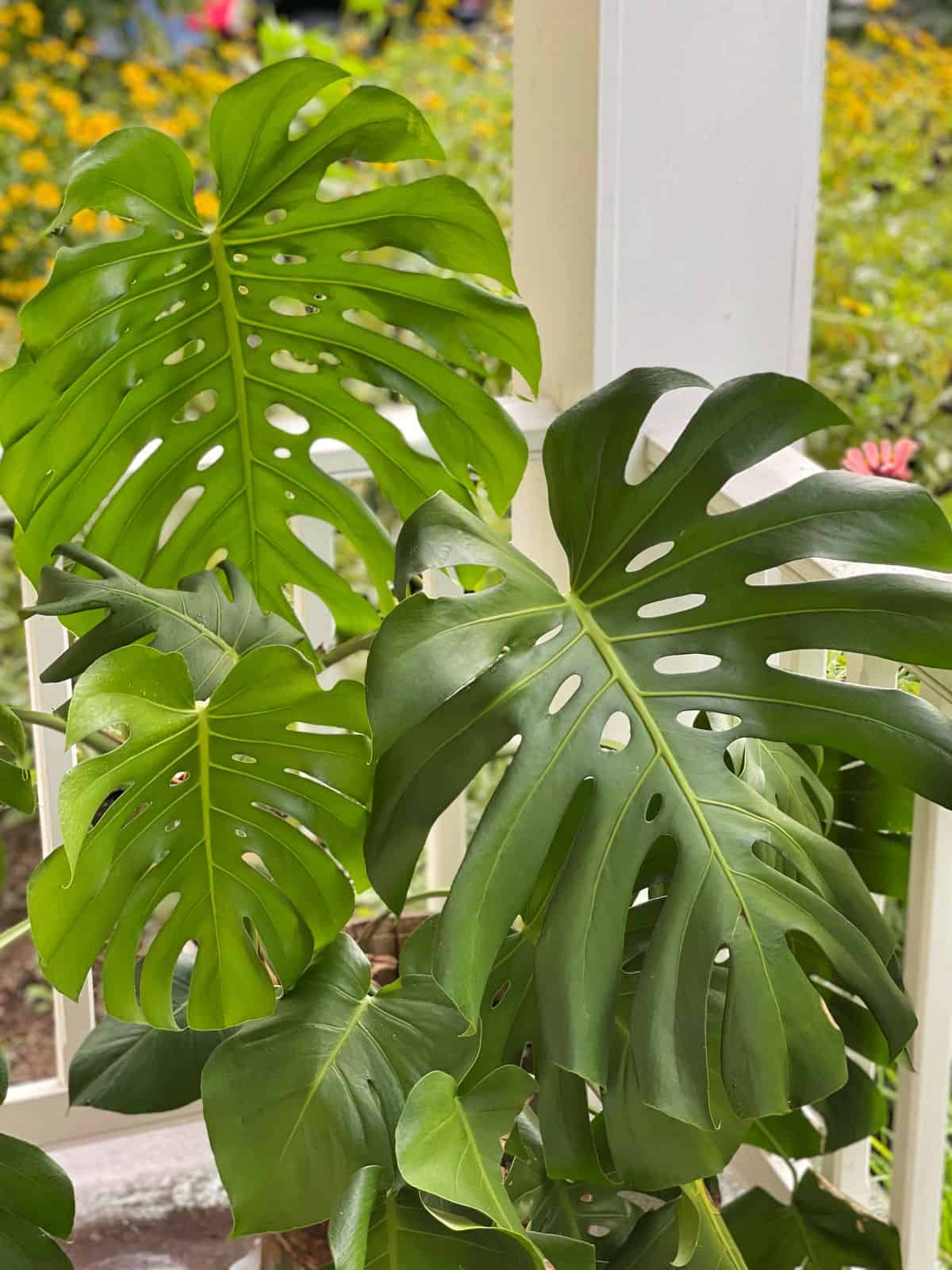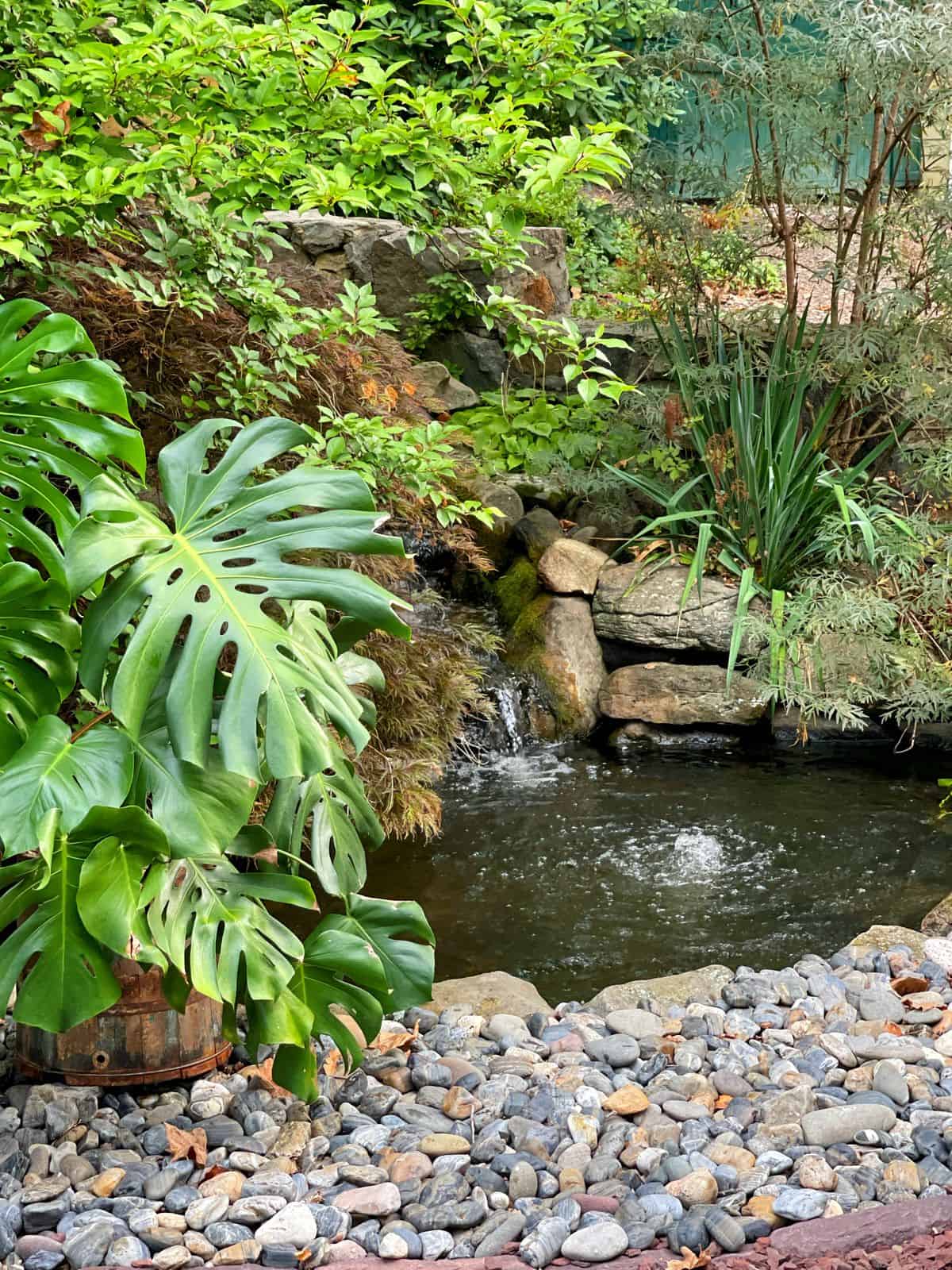No more overwatering and underwatering! Stop guessing and master watering indoor plants like a pro based on their unique needs. Happy houseplants guaranteed!
Raise your hand if you’ve ever felt the crushing guilt of a wilting houseplant, a casualty of your well-intentioned but rigid watering schedule. We’ve all been there, diligently pouring our devotion (and H2O) on a fixed weekly basis, blissfully unaware that our leafy friends might be begging for something entirely different.
The truth is, plants, like people, are individuals with unique needs. What might be a life-giving drink for your beautiful monstera could be a soggy death knell for your drought-tolerant succulent. Thus, you might be overwatering or underwatering your indoor plants without even realize you’re doing it.
So, let’s stop doing the one-size-fits-all approach and chat about how to understand your plant’s thirst cues. In today’s post, I’m going to help you change your approach to watering plants indoors so your houseplants thrive. Are you ready to be the plant parent you’ve always wanted to be? Let’s go!
(Posts on stacyling.com may contain affiliate links. Click HERE for full disclosure.)

Overwatering vs Underwatering: Finding the Right Balance
It’s easy to get confused about whether your plant needs more water or less. Both overwatering and underwatering can cause similar symptoms, but there are some key differences to look out for.
Overwatering
Overwatering happens when the soil stays too wet for too long. This prevents the roots from getting the oxygen they need, essentially drowning them. Overwatering does not mean how much water you give a plant at once but rather, how often you are watering your plants and whether or not that plant needs it. Here’s what to watch for:
Symptoms
- Yellowing leaves
- Mushy stems
- Soil that stays wet for a long time
- Foul odor from the soil (a sign of root rot – see more on this below)
- Gnats around the plant (they’re attracted to the moist conditions)
Causes
- Watering too frequently
- Using a pot that’s too large (holds excess water)
- Poor drainage (water can’t escape)
- Heavy, dense soil that retains too much moisture

Underwatering
Underwatering occurs when the plant doesn’t get enough water to thrive. This can cause stress and damage. Here are the signs:
Symptoms
- Dry, crispy leaf tips or edges
- Wilting leaves that feel dry to the touch
- Soil pulling away from the sides of the pot
- Leaves dropping (plant tries to conserve water)
- Slow growth
Causes
- Not watering enough
- Using a pot that’s too small (dries out quickly)
- Well-draining soil that dries quickly
- Hot, dry environments

Why Skipping Schedules Makes Sense
Think about it: in nature, no plant receives a pre-programmed water timer. They rely on subtle signals like soil moisture, sunlight, and temperature to dictate their thirst. Blindly sticking to a schedule ignores these crucial factors, often leading to overwatering, the silent killer of houseplants.
The biggest reason indoor plants die is from overwatering them. It’s a common mistake that even experienced gardeners make, but is very easy to fix. So don’t sweat it if this has happened to you. It’s happened to the best of us at some point or another in our gardening lives so now, we learn to become better gardeners from what we are doing wrong. Don’t beat yourself up over it.
Paying Attention to Seasonal Rhythms
Just like us, plants adapt to seasonal changes. During the winter most indoor plants enter a state of dormancy, slowing down their metabolism and usually requiring less water. If you persist with your summer watering routine, and you risk drowning their slumbering roots.
In addition, dry heat from the indoor air can also dry the soil out much faster than during the warmer months too. So it’s really important to pay attention to your the soil and your plant’s needs in the home conditions that you have. Make sense?
Listen to Your Plants
Remember, your plants are constantly communicating their needs. Observe their leaves, stems, and soil. Wilting, drooping, or yellowing foliage are cries for help. Don’t ignore these changes and instead, investigate what’s going on. Is it getting too much light? Too much water? Have you fertilized it recently? (To drill down on understanding your home’s light conditions, read this article I shared here.)
Conversely, perky leaves and new growth signal contentment. By paying attention to these subtle cues, you’ll develop a deep understanding of your plant’s individual rhythm that will help you create an indoor garden that thrives.

How We Over Water Plants Indoor
There are a few ways we tend to over water houseplants. Do any of these sound familar? If so, stop doing them and let’s approach watering indoor plants differently.
- We want to schedule ourselves on the same day every week to water plants so we don’t forget. DON’T DO THIS! It’s a surefire way to drown your indoor plants.
- We might also look at the soil surface, think the plant is dry, and needs water. So we water it more. Then, as those plants start to decline, many think it’s thirsty and needs even more water. So then you water again. The problem with that is, the plant might already be over-saturated near the roots and instead of allowing it to dry out, you’re giving it more water which leads to root rot and plant decline.
The problem with both of these methods is that the soil where the roots are may not actually be dry. And if the soil is not really dry, then plant roots sit in a wet soggy mess that promotes pest and disease problems.
So just because the top layer of soil looks dry doesn’t mean it is. And, the plant may not “need” to be watered on the scheduled watering day.
How Does Soil Retain Water and Still Look Dry?
Wet soil is very similar to a sponge. If you soak a sponge and hold it upright, water collects at the bottom while the top dries out. Soil acts in the same way. So the soil surface may look and feel dry, but may not be dry where the roots are located. Now that we understand how the soil retains moisture near the roots, how can you tell whether it’s dry or not?

The Importance of Soil Quality
Before we get into learning when to water, we’ve got to talk about soil quality because it plays a crucial role in the health of your houseplants. A good potting mix should provide adequate drainage, aeration, and moisture retention. However, some potting mixes hold onto more moisture than houseplants need, which can lead to root rot and other problems.
Choosing the Right Potting Mix
When choosing a potting mix, it is important to select one that is appropriate for the type of plant you are growing. For example, succulents and cacti need a well-draining potting mix that is designed for succulents, while ferns and other moisture-loving plants need a potting mix that retains more moisture.
You can also make your own potting mix by combining different ingredients, such as peat moss, perlite, and vermiculite. This allows you to create a custom mix that is perfect for the needs of your plants.
For many of my houseplants, I like to make my own chunky soil mix that includes peat moss, perlite, potting mix, and orchid bark to ensure good drainage. But you can also buy a chunky soil mix premade for you too!
In addition to the type of potting mix you use, it is also important to consider the size of the pot. A pot that is too large will hold too much moisture, which can lead to root rot. A pot that is too small will dry out too quickly.

Tips for Maintaining Healthy Soil
Here are a few tips for maintaining healthy soil for your houseplants:
- Repot your plants regularly. As your plants grow, they will need to be repotted into larger pots. This will give them fresh potting mix and more room to grow. Some plants prefer to be rootbound so before sizing up, know your plant!
- Aerate the soil. You can aerate the soil by poking holes in it with a fork or chopstick. This will help to improve drainage and prevent the soil from becoming compacted.
- Add compost to the soil. Compost is a great way to add nutrients to the soil. You can add compost to your potting mix or topdress your plants with it. I shared a great diy compost recipe here.
- Avoid overwatering. Overwatering is one of the most common causes of houseplant problems. Be sure to let the soil dry out between waterings.

The Benefits of Clear Nursery Pots
While decorative pots might be all the rage when we repot our plants, don’t underestimate the humble clear nursery pot. These simple containers offer a surprising advantage when it comes to understanding your plant’s needs.
Clear pots provide a literal window into the root system of your plant and the condition of the soil. This visual access helps you monitor root health, assess soil moisture, prevent overwatering, know best when to repot.
I LOVE using clear nursery pots like this in decorative planters because they are easy to lift out, I can see the roots and soil, and easily take the plant to my kitchen sink for a good soaking.

How to Determine Whether Houseplants NEED to be Watered: The Art of the Finger Test
While I mentioned having a scheduled watering day could be harmful to plants, it is good to plan one so that watering is on your radar. So what will you be doing on that scheduled day? You are going to check the soil for dryness instead of blindly watering every week. No more mindless watering because we will be doing it with more intention. Here’s how!
Use your finger, popsicle stick, or even a plastic knife and gently poke the soil about an inch deep. Does it feel wet? Is there soil on it?
If it’s dry, give your plant a drink. But if it is still damp? Hold off and check again tomorrow. This method accounts for factors like pot size, soil type, and plant variety, ensuring the care you give is tailored to that plant’s needs.
Bonus Tip: Invest in a moisture meter like this one for extra guidance, especially for plants with deeper root systems where the finger test might not reach.
I know this sounds like a task but you will get to know your plants and their watering needs after a few weeks and not need to do this as often.
Pro-Tip for New Plants: It’s a good idea to use the cake batter test for the first few weeks of care so you get to know the plant and its watering requirements.

How to Water Indoor Plants the Right Way
It is so important to strike the right balance when watering indoor plants because there are lots of different factors that go into watering plants at the right time. It’s a good idea to check your plants weekly to see if they NEED to be watered. Keep in mind that just because you are checking, doesn’t mean they actually need to be watered.
The Do’s and Don’ts of Watering Plants Indoors
- Use a watering can: A watering can spout directs water to the base, avoiding splashes and puddles. This helps you focus on watering where plants need it most, their roots.
- Give plants a shower: It’s a good idea to give houseplants a monthly shower to wash off any dust or debris and give them a good soil soaking.
- Water plants in your kitchen sink: You’ll know you gave plants a good soaking when you use a sink faucet. Allow the water to completely drain out before putting it back in it’s home.
- Avoid Softened Water: Sodium from softeners can harm your plants. Use outdoor spigots, filtered water, or purified options instead.
- Check the Soil for Moisture: Dig in before you give plants water. Each plant has its own rhythm, so check them individually.
- Only Water Plants When Necessary: Set reminders to assess your plants, but ditch rigid schedules. Some need more frequent drinks than others, and seasons can shift their thirst. Learn your plants.
- Water Deeply: A good drench is key not a shallow watering. Mimmick rainfall not a superficial drink of water. Thoroughly soak the soil until water drains from the pot’s bottom. This encourages healthy root growth.
- Keep Plants Out of Standing Water: Allowing plants to sit in water is a recipe for disaster. If you overdo it, use a turkey baster to remove excess water.

How to Fix Soggy Soil After Watering Indoor Plants Wrong
If you’ve been unknowingly overwatering plants, we can fix the problem and help improve their health.
- Start by cleaning the plant from dust and debris.
- Remove any and all dead growth so the plant doesn’t waste any energy into them.
- Get rid of any mold you see too.
- It’s a good idea to completely repot the plant and give it a fresh start in new potting soil in a clean container.
To clean your container and snips, use 9 parts water to 1 part bleach and clean both well. If leaves are yellowing, the plant can also be stressed from:
- overwatering
- poor drainage
- too much light
Once the plant is repotted in a fresh container, keep it in a location where it can rebound and don’t overwater it! In fact, if the problem was due to overwatering, I’d repot it and leave it alone for a few days before watering it. I shared more tips for reviving houseplants after they decline here. So you’ll want to check out this article for more help with fixing an indoor plant that’s not doing well.

Indoor Plant Leaves Turning Brown and Crispy Tips: Not Always the Sign of Overwatering
Sometimes brown leaf tips or edges can happen on any indoor plant but are common on certain species like spider plant and dracaena. Trimming the brown portions off the leaves with snips or scissors can improve their appearance, but new browning can still occur if the root cause is not addressed. While brown leaf tips can be a sign of overwatering, don’t jump to conclusions. Consider the following factors:
- Overwatering or underwatering: Trim off the brown leaves and be more mindful with watering practices.
- Not enough humidity. Add a humidifier or group plants together to increase humidity.
- Normal aging: If it is the lower leaves on a plant, that is natural aging. Trim that foliage off.
- Too much fertilizer: Overfertilizing can affect roots and cause damage to the foliage by browning out the edges and tips. You may also see buildup on the soil surface. Avoid fertilizing in winter while the plant is dormant and always follow package directions.
- Pest and disease problems: Sometimes plants get brown and crispy from pest and disease problems. Before doing anything, inspect the plant and research common problems for that particular plant. When you google it, add a .edu so you pull up information from an extension website.
- Erratic watering and other care conditions: Evaluate how you’ve been caring for the plant because it could be the result of erratic watering, water you are using, and overfertilizing.

Watering Indoor Plants FAQs
When is the Best Time to Water Indoor Plants?
The best time to water indoor plants is in the morning. So if possible, try to water in the mornings where possible. It’s recommended to water all plants, whether inside or out, in the morning because it allows the plant to absorb the water before the heat of the day causes it to evaporate.
Watering in the morning reduces the risk of fungal growth that can occur when soil and leaves stay wet overnight. And it gives plant foliage time to dry off before evening, which can help reduce the risk of disease. That said, if your plants are dry and in need of water…water them regardless of the time of day!
Can You Water Plants at Night?
While it is generally recommended to water plants in the morning, you can water plants at night if you forget to do it in the morning and they really need it. But I’d avoid doing it if you can.
I do not recommend making watering at night a regular practice. One of the main concerns is that the soil and plant foliage may stay wet for an extended period of time, which can increase the risk of fungal growth and disease. Additionally, if the plant is not able to absorb the water quickly, it can lead to water pooling around the base of the plant, which can lead to root rot.
Also, watering at night can also attract insects and pests which can be harmful to the plants. If you have to water plants at night, try to do it as early as possible and only on a rare occasion.

Can You Bring a Houseplant Back to Life?
I always say if the plant still has some green foliage and stem, there’s a good chance you can save it. Take a look at the roots and see if the roots are white. You can revive plants using these tips.
What is Root Rot and Can My Plant Be Saved?
Root rot is a condition that occurs when the roots of a plant are constantly wet. This can lead to the roots suffocating and dying. Root rot can be caused by a number of factors, including overwatering, poor drainage, and using a potting mix that holds onto too much moisture.
If you think your plant may have root rot, there are a few things you can do. First, check the roots. If they are mushy and brown, then root rot is likely the problem. You can try to save the plant by repotting it in fresh potting mix and watering it less often.
It is important to trim away the rotting roots with clean snips and spray the healthy roots with 3% hydrogen peroxide like this to prevent further bacterial growth.

How Often Should You Water Plants Indoors?
How often you should water plants indoors can be a tricky one to answer! It’s about finding the right balance because there’s no one-size-fits-all answer, as the frequency depends on a variety of factors that include:
- Plant Type: Different plants have different thirst levels. Cacti and succulents, for example, are drought-tolerant and need infrequent watering, while ferns and peace lilies prefer consistently moist soil.
- Pot Size and Material: Smaller pots dry out faster than larger ones, and clay pots lose moisture more quickly than plastic ones. Learn how different container types and how they affect plants in this post.
- Soil Composition: Well-draining soil allows water to flow through easily, meaning you’ll need to water more often. Conversely, dense soil holds onto moisture, so you’ll need to water less frequently.
- Sunlight and Temperature: Plants in bright, hot environments will dry out faster than those in shady, cooler spots. Additionally, plants grow more during the warm season and typically require more water then.
- Seasonality: As winter approaches, many plants enter dormancy and require significantly less water.
When you are evaluating the specific plant you are growing, look at soil dryness, wilting leaves, and it’s growth rate. During active growth periods, plants typically need to be watered more often. Conversely, slower growth during cooler months means reduced water requirements.
By observing these factors and responding to your plant’s individual needs, you’ll master the art of watering and keep your leafy companions thriving. Remember, it’s always better to underwater than overwater, as soggy roots can be fatal.

Should You Water House Plants from Top or Bottom?
It’s always best to water at the base of plants to ensure water is given where plants need it most. When we water from above, those roots don’t receive as much water. And when water is left on plant foliage in cooler conditions, that can lead to pest and disease problems.
However, using a mixture of bottom watering for every day with top watering every now and again will help wash away the build-up of salts and minerals to keep house plants looking lush, healthy, and beautiful.

More About How to Water Plants Indoor
Watering your plants shouldn’t be a chore, but rather a journey of discovery. As you learn to decipher their unique language, you’ll cultivate a deeper connection with your houseplants. So, forget the weekly watering schedule, use your finger, and learn what your plant actually needs!
With a little attention and a lot of love, you can master the art of watering your indoor plants, transforming your home into a vibrant haven of thriving greenery. So, go forth, explore, and let your plants guide you!
How do you water your houseplants? Are they on a weekly watering schedule or do you test the soil for dryness before watering? Do you have any indoor plant care tips you’d like to share? I would love to know more in the comments below.
For more information about watering your houseplants, read this article from University of Maryland Cooperative Extension.

To drill down on houseplant care basics and growing an indoor garden that thrives, please read my articles:
- Easy Houseplants for Busy People: The Low-Maintenance Approach to Growing an Indoor Garden
- From Shop to Home: How to Acclimate Your Tropical Plants
- Stop Guessing and Master Watering Indoor Plants Like a Pro
- How to Revive Houseplants You Thought Were Goners
- Is Your Houseplant Getting Enough Light? Here’s How to Tell.
Thanks for stopping by the blog today!
Enjoy your day! xoxo



Want to Buy Houseplants Online? Shop this Post












